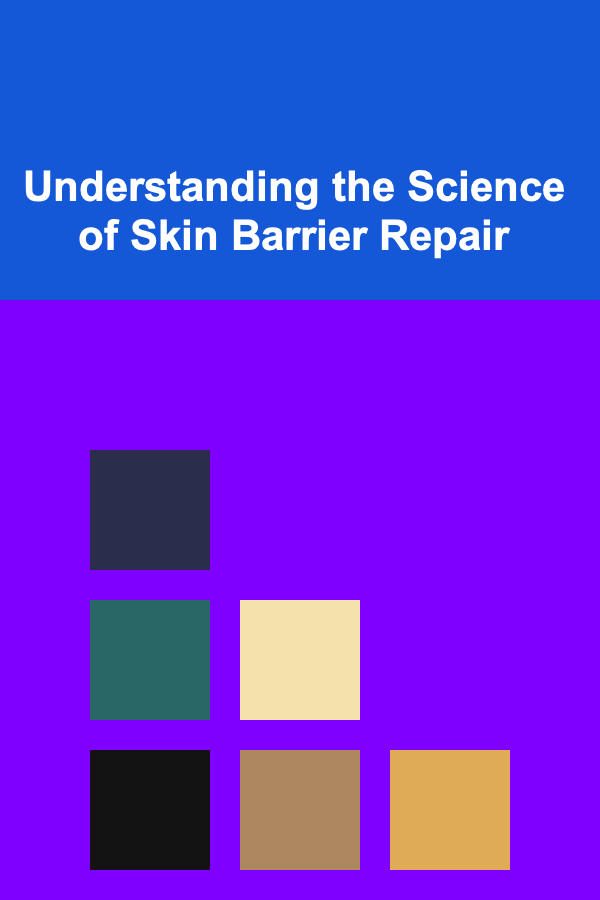
Understanding the Science of Skin Barrier Repair
ebook include PDF & Audio bundle (Micro Guide)
$12.99$10.99
Limited Time Offer! Order within the next:

The skin barrier, also known as the stratum corneum, is the outermost layer of our skin and serves as a critical interface between our bodies and the external environment. Its primary function is to protect us from various external aggressors, including pathogens, irritants, allergens, and UV radiation, while simultaneously preventing excessive water loss from the body. When this barrier is compromised, a cascade of events can occur, leading to a variety of skin conditions and overall discomfort. Understanding the science behind skin barrier repair is crucial for effectively addressing these conditions and maintaining healthy, resilient skin.
The Structure and Function of the Skin Barrier
To comprehend the process of skin barrier repair, it's essential to first understand its intricate structure and multifaceted functions.
The "Brick and Mortar" Model
The skin barrier is often described using the "brick and mortar" model. In this analogy, the "bricks" are flattened, dead skin cells called corneocytes. These corneocytes are densely packed and primarily composed of keratin, a fibrous structural protein that provides strength and resilience. The "mortar" is a complex lipid matrix that surrounds and binds the corneocytes together. This lipid matrix is composed primarily of ceramides, cholesterol, and free fatty acids, in roughly a 1:1:1 ratio. This precise ratio is crucial for maintaining the barrier's integrity and proper function.
The unique arrangement of these components creates a highly organized and impermeable layer. The lipids are arranged in multiple layers, forming lamellar structures that provide a waterproof seal. These lamellar structures are synthesized and secreted by organelles called lamellar bodies within the keratinocytes (the living cells that produce the corneocytes) as they differentiate and migrate towards the skin surface. The process of creating and organizing these lamellar structures is essential for a healthy skin barrier.
Key Functions of the Skin Barrier
The skin barrier performs several vital functions:
- Protection from External Aggressors: It acts as a physical barrier against bacteria, viruses, fungi, and other pathogens, preventing them from entering the body and causing infection. It also protects against environmental irritants like pollution, chemicals, and harsh weather conditions.
- Prevention of Transepidermal Water Loss (TEWL): This is arguably the most important function. The skin barrier prevents excessive evaporation of water from the body, maintaining proper hydration levels within the skin and preventing dryness. A compromised barrier leads to increased TEWL, resulting in dry, itchy, and irritated skin.
- Regulation of Skin Permeability: While primarily a barrier, the skin also needs to allow certain substances, such as medications and nutrients, to penetrate. The skin barrier regulates the passage of these substances, ensuring that only beneficial or necessary compounds are absorbed.
- UV Protection: While not the primary mechanism of UV protection (melanin produced by melanocytes is more important), the stratum corneum contributes by scattering and absorbing some UV radiation.
- Sensory Perception: Nerve endings located within the skin allow us to sense touch, temperature, pain, and pressure. The integrity of the skin barrier is essential for proper sensory function.
Factors That Compromise the Skin Barrier
Numerous factors can disrupt the delicate balance of the skin barrier, leading to its impairment. Understanding these factors is the first step towards effective repair.
Environmental Factors
- Harsh Weather Conditions: Extreme temperatures, low humidity, and strong winds can strip the skin of its natural oils and disrupt the lipid matrix, leading to dryness and increased TEWL.
- UV Radiation: Prolonged exposure to UV radiation damages skin cells, including keratinocytes and the lipid matrix, compromising the barrier's integrity and accelerating skin aging. UV radiation also promotes inflammation, further disrupting barrier function.
- Pollution: Air pollutants, such as particulate matter and ozone, can penetrate the skin and generate free radicals, which damage skin cells and lipids. These pollutants also trigger inflammation and impair the skin's natural repair mechanisms.
Lifestyle Factors
- Harsh Cleansers and Soaps: Many soaps and cleansers contain harsh surfactants that strip the skin of its natural oils, disrupting the lipid matrix and increasing TEWL. Over-washing can also exacerbate the problem.
- Over-Exfoliation: While exfoliation can be beneficial for removing dead skin cells and promoting cell turnover, excessive exfoliation can damage the skin barrier and lead to irritation and inflammation.
- Hot Water: Washing with hot water can dissolve the skin's natural oils and disrupt the lipid matrix, leading to dryness and irritation.
- Poor Diet and Hydration: A diet lacking in essential fatty acids, vitamins, and antioxidants can compromise the skin's ability to repair and maintain its barrier function. Dehydration also reduces the skin's hydration levels, making it more vulnerable to damage.
- Stress: Chronic stress can elevate cortisol levels, which can disrupt the skin's natural repair processes and contribute to inflammation.
Underlying Skin Conditions
- Eczema (Atopic Dermatitis): This chronic inflammatory skin condition is characterized by a genetically predisposed defect in the skin barrier, making it more susceptible to irritation and inflammation. Individuals with eczema often have reduced levels of ceramides in their skin.
- Psoriasis: This autoimmune skin condition is characterized by rapid skin cell turnover, which disrupts the normal maturation process of keratinocytes and leads to a compromised skin barrier.
- Rosacea: This chronic inflammatory skin condition can be associated with a disrupted skin barrier, leading to increased sensitivity and redness.
- Ichthyosis: This is a group of genetic skin disorders characterized by dry, scaly skin due to defects in skin barrier formation.
Medications and Treatments
- Topical Corticosteroids: While effective for reducing inflammation, long-term use of topical corticosteroids can thin the skin and impair barrier function.
- Retinoids: Retinoids, such as tretinoin and retinol, can improve skin cell turnover and collagen production, but they can also cause dryness and irritation, particularly during the initial stages of use.
- Acne Treatments: Many acne treatments, such as benzoyl peroxide and salicylic acid, can be drying and irritating, potentially compromising the skin barrier.
The Science of Skin Barrier Repair: A Multi-Faceted Process
Skin barrier repair is a complex and dynamic process involving several key cellular and molecular mechanisms. Understanding these mechanisms is crucial for developing effective strategies to restore and maintain a healthy skin barrier.
Lipid Synthesis and Organization
The most critical aspect of skin barrier repair is the restoration of the lipid matrix. This involves the synthesis, transport, and organization of ceramides, cholesterol, and free fatty acids.
- Ceramide Synthesis: Ceramides are the most abundant lipids in the stratum corneum and play a crucial role in maintaining barrier function. Their synthesis involves a complex series of enzymatic reactions within keratinocytes. Enzymes like serine palmitoyltransferase (SPT) and ceramide synthase (CerS) are essential for ceramide production. Damage to these enzymes or a deficiency in their substrates can lead to reduced ceramide levels and impaired barrier function.
- Cholesterol Synthesis: Cholesterol is another essential lipid component of the skin barrier. Its synthesis involves a series of enzymatic reactions, starting with acetyl-CoA and ultimately leading to the production of cholesterol. Cholesterol helps to maintain the fluidity and stability of the lipid matrix.
- Free Fatty Acid Synthesis: Free fatty acids contribute to the acidification of the skin surface (the "acid mantle"), which is important for maintaining a healthy skin barrier and inhibiting the growth of pathogens. Their synthesis involves enzymes like fatty acid synthase (FAS).
- Lamellar Body Secretion: As keratinocytes differentiate and move towards the skin surface, they produce organelles called lamellar bodies. These lamellar bodies contain a mixture of lipids, enzymes, and other molecules that are essential for forming the lamellar structures of the lipid matrix. The secretion of these lamellar bodies into the intercellular space is a crucial step in skin barrier formation.
- Lipid Organization: Once the lipids are secreted, they must be organized into the correct lamellar structure to form an effective barrier. This process is influenced by factors such as the lipid composition, temperature, and the presence of specific enzymes. Proper lipid organization is essential for maintaining the barrier's impermeability.
Keratinocyte Differentiation and Corneocyte Formation
Keratinocytes undergo a process of differentiation as they move from the basal layer of the epidermis to the stratum corneum. This process involves changes in gene expression, protein synthesis, and cellular morphology.
- Early Differentiation: In the lower layers of the epidermis, keratinocytes express proteins like keratin 5 and keratin 14. As they begin to differentiate, they start to express keratin 1 and keratin 10.
- Late Differentiation: As keratinocytes move into the granular layer, they begin to synthesize proteins like filaggrin and loricrin. Filaggrin plays a crucial role in aggregating keratin filaments, leading to the formation of flattened corneocytes. Loricrin is a major component of the cornified envelope, a protein-rich layer that surrounds the corneocytes and provides them with structural support.
- Cornification: The final stage of keratinocyte differentiation is cornification, in which the cells lose their nuclei and organelles and become flattened, dead corneocytes. These corneocytes are packed with keratin and surrounded by the cornified envelope. The process of cornification is essential for forming the "bricks" of the skin barrier.
Inflammation Resolution
A compromised skin barrier often triggers an inflammatory response, which can further disrupt barrier function. Resolving this inflammation is crucial for promoting skin barrier repair.
- Cytokine Modulation: Inflammation is driven by the release of cytokines, such as interleukin-1 (IL-1), interleukin-6 (IL-6), and tumor necrosis factor-alpha (TNF-α). These cytokines activate immune cells and promote inflammation. Repairing the skin barrier requires modulating the production and activity of these cytokines.
- Antioxidant Defense: Inflammation can generate free radicals, which can damage skin cells and lipids. The skin has its own antioxidant defense system, which includes enzymes like superoxide dismutase (SOD) and catalase, as well as antioxidants like vitamin C and vitamin E. Boosting the skin's antioxidant defense can help to protect against free radical damage and promote barrier repair.
- Resolution of Inflammation: The inflammatory response needs to be resolved in a timely manner to prevent chronic inflammation. This involves the production of anti-inflammatory mediators, such as resolvins and lipoxins, which help to dampen the inflammatory response and promote tissue repair.
Wound Healing Mechanisms
In some cases, skin barrier damage can be accompanied by minor wounds or abrasions. In these situations, wound healing mechanisms are also involved in the repair process.
- Cell Migration and Proliferation: Keratinocytes surrounding the wound edge migrate and proliferate to cover the wound surface. This process is stimulated by growth factors and cytokines.
- Collagen Synthesis: Fibroblasts in the dermis synthesize collagen, which provides structural support to the new tissue.
- Angiogenesis: New blood vessels form to supply the healing tissue with nutrients and oxygen.
- Remodeling: The newly formed tissue is remodeled over time to restore its original structure and function.
Strategies for Skin Barrier Repair
Based on our understanding of the science of skin barrier repair, we can develop effective strategies to restore and maintain a healthy skin barrier.
Topical Emollients and Moisturizers
Emollients and moisturizers are essential for repairing a compromised skin barrier. They work by replenishing the skin's natural lipids, reducing TEWL, and improving hydration.
- Ceramide-Containing Products: Ceramides are a key component of the skin barrier, and topical application of ceramide-containing products can help to restore the lipid matrix and improve barrier function. Look for products that contain a combination of ceramides, cholesterol, and free fatty acids in a 1:1:1 ratio.
- Occlusive Ingredients: Occlusive ingredients, such as petrolatum, mineral oil, and dimethicone, form a protective layer on the skin surface, preventing TEWL and improving hydration.
- Humectants: Humectants, such as hyaluronic acid, glycerin, and urea, attract moisture from the environment and draw it into the skin, increasing hydration levels.
- Emollients: Emollients, such as shea butter, cocoa butter, and plant oils, soften and smooth the skin by filling in the spaces between corneocytes and improving the flexibility of the stratum corneum.
Gentle Cleansing Practices
Harsh cleansers can strip the skin of its natural oils and disrupt the lipid matrix. Using gentle cleansing practices is crucial for maintaining a healthy skin barrier.
- Use a Mild, Soap-Free Cleanser: Avoid cleansers that contain harsh surfactants like sodium lauryl sulfate (SLS) and sodium laureth sulfate (SLES). Look for cleansers that are labeled as "soap-free" or "for sensitive skin."
- Wash with Lukewarm Water: Avoid washing with hot water, as it can dissolve the skin's natural oils.
- Pat Dry: Avoid rubbing the skin with a towel, as this can cause irritation. Instead, pat the skin dry gently.
- Moisturize Immediately After Cleansing: Apply a moisturizer immediately after cleansing to lock in moisture and protect the skin barrier.
Sun Protection
UV radiation can damage the skin barrier and impair its function. Protecting the skin from the sun is essential for maintaining a healthy skin barrier.
- Use a Broad-Spectrum Sunscreen: Apply a broad-spectrum sunscreen with an SPF of 30 or higher every day, even on cloudy days.
- Seek Shade: Avoid prolonged sun exposure, especially during peak hours (10 am to 4 pm).
- Wear Protective Clothing: Wear protective clothing, such as hats and long sleeves, to shield your skin from the sun.
Diet and Hydration
A healthy diet and adequate hydration are essential for maintaining a healthy skin barrier.
- Consume Essential Fatty Acids: Essential fatty acids, such as omega-3 and omega-6 fatty acids, are important for maintaining the integrity of the lipid matrix. Include foods rich in these fatty acids in your diet, such as fatty fish, flaxseeds, and walnuts.
- Eat a Balanced Diet: A diet rich in fruits, vegetables, and whole grains provides the skin with the nutrients it needs to repair and maintain its barrier function.
- Stay Hydrated: Drink plenty of water throughout the day to keep your skin hydrated.
Stress Management
Chronic stress can disrupt the skin's natural repair processes. Managing stress is important for maintaining a healthy skin barrier.
- Practice Relaxation Techniques: Practice relaxation techniques, such as meditation, yoga, and deep breathing, to reduce stress levels.
- Get Enough Sleep: Aim for 7-8 hours of sleep per night to allow your body to repair and regenerate.
- Engage in Regular Exercise: Regular exercise can help to reduce stress and improve overall health.
Specific Ingredients to Look For
Certain ingredients are known to be particularly beneficial for skin barrier repair:
- Niacinamide (Vitamin B3): Improves ceramide synthesis, reduces inflammation, and enhances skin barrier function.
- Panthenol (Pro-Vitamin B5): A humectant and emollient that helps to hydrate and soothe the skin.
- Colloidal Oatmeal: Soothes irritated skin and reduces inflammation.
- Allantoin: A soothing and skin-protecting ingredient.
- Prebiotics and Probiotics: Can help to balance the skin microbiome and improve barrier function. Topical application is becoming increasingly popular, though research is ongoing.
- Madecassoside (Centella Asiatica): A potent antioxidant and anti-inflammatory ingredient that promotes wound healing and skin repair.
Conclusion
The skin barrier is a complex and vital structure that protects us from the external environment and prevents excessive water loss. Understanding the science behind skin barrier repair is essential for effectively addressing skin conditions and maintaining healthy, resilient skin. By understanding the structure and function of the skin barrier, the factors that compromise it, and the mechanisms involved in its repair, we can develop effective strategies to restore and maintain its integrity. This includes using appropriate topical products, adopting gentle cleansing practices, protecting the skin from the sun, maintaining a healthy diet and hydration, and managing stress. By incorporating these strategies into our daily routines, we can help to keep our skin healthy, hydrated, and protected.

How to Install and Maintain Permanent Outdoor Lights
Read More
How to Organize Small Bathroom Cabinets for Maximum Storage
Read More
How to Reassess and Adjust Your Remote Work Strategies Regularly
Read More
How to Understand the Structure of a Symphony
Read More
Quick & Healthy Fish Dinners: A Comprehensive Guide
Read More
10 Tips for Managing RSVP Responses on Your Wedding Guest List
Read MoreOther Products

How to Install and Maintain Permanent Outdoor Lights
Read More
How to Organize Small Bathroom Cabinets for Maximum Storage
Read More
How to Reassess and Adjust Your Remote Work Strategies Regularly
Read More
How to Understand the Structure of a Symphony
Read More
Quick & Healthy Fish Dinners: A Comprehensive Guide
Read More